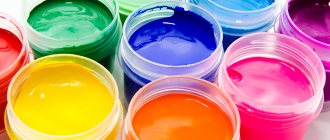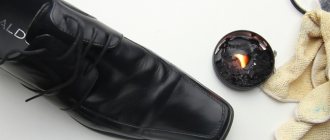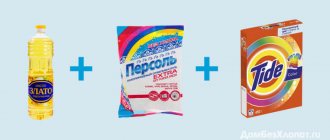Interior decoration is not a simple construction process. It involves a lot of effort in carrying it out. Today people want to carry out repairs on their own to save money, and sometimes to show off their talent. This fact is especially important for owners who are painting their house or apartment.
Water-based paint stains are a common problem after renovation.
One of the favorite means of repair is water-based paint - this is a popular, high-quality and promising material. Water-based paint will give your walls and ceiling a finished, neat look in the shortest possible time. Sometimes, after repairs, stains remain after painting on pieces of furniture and clothing; this article is devoted to the problem of how to wash water-based paint after repairs.
Other types of paints
Gouache, watercolor
Dyes of this type are water-soluble and can be easily washed at home. Freshly soiled items can be washed with laundry soap in cold water, and then continue removing stains using a regular machine wash in the appropriate mode for the type of fabric.
To remove gouache stains with an adhesive or oil base, prepare a solution of ammonia and oxalic acid in 1:1 proportions, in which the clothes are soaked for 30 minutes.
Oil paints
When oil paints harden, they form a dense crust on the surface that can be carefully removed. Soften small grains of paint with sunflower or olive oil and remove the stain. Grease stains left behind by oil are not difficult to wash off in boiling water with dishwashing detergent; it breaks down fats perfectly and not a trace of the stain will remain.
Acrylic paint
Acrylic paint stains are one of the most difficult to remove; in many cases, a stained item cannot be saved. If the stain is fresh, you can prepare a solution of ammonia, vinegar and salt, take the ingredients at a ratio of 1:1:1, apply this mixture to the stained area and leave for about fifteen minutes until the solution takes effect, then wash it in the usual way.
Acrylic paint should be scrubbed with a mixture of ammonia, vinegar and salt
Basic Rules
Before you wash paint from clothes, you should prepare for the process of removing complex stains by studying the basic recommendations.
- The main condition for successfully getting rid of a stain is speed of action. The sooner you start cleaning, the greater the chance of eliminating contamination with minimal harm to the material.
- It will be useful to know the type of paint that ended up where it was not supposed to be, and the type of textile. The latter is necessary so that using aggressive substances does not cause even more damage to clothing.
- Before removing a large amount of dried paint, clean off the top layer with the blunt side of a knife. Only after this the action of the solvent will be as effective as possible.
- Before the procedure, you need to protect the skin of your hands - wear gloves, for example. cotton with PVC coating, which can be purchased at https://plenka-voronezh.ru/shop/420-rabochie-perchatki-hb.
- Before using concentrates with a strong chemical odor, you must open the window in the room.
- When there is doubt about the tissue's reaction to a solvent, it is better to first conduct the experiment on a small, inconspicuous area.
- To prevent the paint from imprinting on another part of the clothing while removing the stain, you should lay the item out rather than fold it. It would be even safer to place a napkin under the stain.
- Products made from thin textiles are more difficult to clean than those made from thick materials. For example, it is easier to remove a stain from trousers than from a blouse.
Each case of contamination requires an individual approach to cleaning.
How to remove water-based paint from clothes
Water-based paint is, without a doubt, the leader in sales among paints and varnishes. And, of course, every person should know how to wipe off water-based paint. When painting walls or ceilings, the paint will definitely get on clothes, furniture, and floors.
Clothes and hands are the first things to start with. Fresh stains on clothing should be removed using a simple principle: from edge to center. By following the basic steps, the stains will quickly disappear.
It is important to make sure before cleaning and try the product on the edge of the clothing so as not to completely ruin the item. It is equally important to check your own reaction on your hand to avoid harmful allergic consequences.
Fresh water-based paint can be easily removed using plain water. Once the stains have dried, it will take some effort. You can use pure gasoline, thinner, alcohol, kerosene. You need to apply the product onto a cotton swab. For example, alcohol can easily remove old paint.
You can also remove water-based paint from clothes by soaking it in a special solution. You will need: vinegar, warm water and salt. Mix all ingredients in proportions 2*2*2. Pour onto the soiled item of clothing and leave for two hours. Afterwards, you can wash it.
When standard methods for removing stains from things do not help, you should turn to specialists and use dry cleaning services.
How to remove water-based emulsion from different types of fabric
Depending on the composition and structure of the material, special means are used to remove traces of color.
- You can wipe off dirt on silk or chintz using purified gasoline. Place a white cotton cloth under the stain and a layer of blotting paper on top. Moisten a cotton sponge with the liquid and wipe the problem area with it, moving from the edges to the center. When the dirt has completely disappeared, treat the area where the paint was with paper, wash the item well in warm water with powder or soap, and then dry in the fresh air.
- White spirit will help get rid of stains on thick denim or tarpaulin. Rub the problem area with a sponge soaked in solvent, then wash the item and air dry.
- When cleaning synthetics, you should not use either gasoline or solvent, as they will destroy the fibers of the fabric. Vegetable oil will come to the rescue. You need to place a white cloth and a piece of cellophane under the stain so that the fat does not spread to other places, and rub the stain with a sponge generously moistened with oil. It may take a long time for the color marks to disappear. Finally, all that remains is to get rid of the greasy stain, which a degreaser dishwashing detergent will help remove. Some people use a cotton swab soaked in a soap solution.
Please note that old stains that have dried on the product may initially require mechanical removal using a knife or scraper. Do not use such tools on thin fabrics that are easily damaged.
How to remove water-based paint from a stretch ceiling
Stretch ceilings come in different types and configurations:
- Fabric ceiling;
- PVC ceiling material.
When paint gets on a fabric ceiling, it is important to study the information in detail so as not to damage the product. It is much more difficult to wash. As a rule, fabric ceiling coverings are washed with a solution of soap and water. The rag should be thoroughly wrung out; the fabric is afraid of moisture and will take a long time to dry. You can try removing difficult stains using a mixture of baking soda and salt. When dry, rinse with water. It is important not to use glass cleaner; the fabric will change color.
It is advisable to wipe off fresh paint on PVC structures as well. If it doesn’t work out in time, you can moisten the spots with water so that the paint swells and quickly peels away from the ceiling structure. Also, water-based paint can be wiped off with a small amount of solvent.
The gloss will not lose its shine if you wash the ceiling with a solution of alcohol, mirror liquid, alcohol-based. Circular movements will leave streaks. Wipe the treated ceiling surface dry.
The room should be ventilated after such procedures. Unpleasant odors of alcohol or gasoline will disappear quickly if you turn on the fan and create a draft.
more about how to remove paint from a suspended ceiling (water-based, oil-based and acrylic) here.
How to deal with fresh stains
It is much easier to deal with fresh stains, because they have not yet had time to eat into the fibers of the material. Often it is enough to simply wash the item in warm water. If this doesn't help, try one of the two methods below.
Light fabrics just need to be soaked in a soap solution, then lightly rubbed with your hands and rinsed with warm water. Laundry soap works well with water-based paint based on PVA glue.
If the composition contains all kinds of resins, alcohol or vinegar will come to the rescue. But be careful with vinegar: it is not recommended to use it on bright colored fabrics.
If the color remains on a delicate fabric, it is recommended to check the safety of the product in an inconspicuous area before removing it.
How to remove stains from water-based paint
Walls or ceilings painted with water-based paint can be washed with a solution of water and soda in equal proportions: 4*4. This mixture will help get rid of traces of pencil, ink, abrasions from interior items, and shiny stains. It is enough to leave for 10 - 15 minutes and wipe with a slightly damp cloth.
Grease stains on water-based paint can be wiped off with simple stationery chalk. The stains should be rubbed well, then cleaned with a regular napkin or a soft-bristled brush. Perform the steps several times. The chalk can be finely crumbled onto a rag, then applied to the stain, take a hot iron and iron thoroughly. When chalk doesn't help get rid of grease marks on the paint, the only thing left to do is repaint the area.
The following materials and tools will help you completely remove unsightly stains from water-based paint:
- Metal spatula;
- Primer: acrylic and deep;
- Paint of a suitable tone;
- Container for washing;
- Gloves;
- Roller;
- Chlorine solution, bleach;
- Brush with soft bristles;
- Paint container.
For any spot the actions will be the same. Remove the contaminated coating and then prime the area. And when the primer dries, apply a fresh coat of paint.
It is not recommended to wash water-based coatings with hard brushes, rollers, or very damp rags - there will be unsightly stains. Also, the abrasive substances of detergents will damage the surface, the smell will not disappear and the structure will have to be replaced.
It is better to remove paint stains on objects, things, plastic products or linoleum immediately before they dry. Old paint can be removed using products, solutions, brushes and a spatula. The main thing is to act carefully if greasy stains have become embedded on the surface of the water-based paint.
Recommendations
To remove water-based emulsion, it is recommended to use the following tips:
- If it is necessary to remove old paint from a large area (walls, ceiling), all objects in the room should first be covered with film.
- Repair work should be carried out using personal protective equipment - respirator, gloves, goggles.
Fresh splashes and stains of water-based paint must be removed immediately and washed with water.- Preliminary moistening of the surface with a water-based coating must be carried out in small areas, acting gradually.
- When doing repair work, you should not layer water emulsion of one color on top of another color.
- It is advisable to carry out construction and repair work in the warm season, when the air temperature does not drop below +18°C.
- Cheap safety glasses, which are necessary especially when removing paint from the ceiling, are significantly inferior in quality and convenience to expensive models. One of their disadvantages is poor visibility, which affects the speed and accuracy of work.
How to remove marks from acrylic and latex
Fresh stains that appear on the fabric from these substances can be easily washed off. You need to place the item turned inside out with the stain under running cold water. Then squeeze thoroughly and wash as usual at 30°C.
If there is no result, proceed according to the following scheme:
- Sprinkle a thin layer of washing powder onto the stain.
- Rub the stain with an unnecessary toothbrush or a small similar tool with dense bristles.
- Rinse in hot water.
- Machine wash on a high temperature setting.
If there is a trace left after such actions, it is removed with a stain remover.
Where to start cleansing
You need to get rid of stains wisely. Paint comes off quickly and easily from things if you follow the basic rules. It is important not to spoil your clothes with cleaning products, since in this case it will no longer be possible to “reanimate” them. The rules for eliminating paint stains are simple and universal for all types of material:
- The cleaning mixture is first applied to a small piece of cloth. After 30 minutes, the reaction of the material to the solution is visible. If the fabric has not changed texture or color, you can begin to remove the dirt.
- Cleaning is carried out in a suitable place. Some types of stains can be removed with aggressive substances: gasoline, kerosene, bleach, etc. To minimize the risk of a wiring fire and to avoid inhaling harmful fumes, it is better to clean near an open window.
- The surface on which the contaminated item is placed should not be painted or varnished. Otherwise, you can damage the parquet, window sill, table, etc.
- To clean things with linings, you need to make pads from polyethylene and white fabric. This is the key to good moisture absorption and the absence of streaks.
- Stains can only be removed with cotton pads or a white cloth. Dark material can fade and further damage the item.
Paint stains from clothes can be washed at home.
The easiest to remove are: gouache, watercolor, water-based paints and tempera. They dissolve with water. The item will be clean after hand or intensive machine washing. Stains from paints that contain oil are more difficult to remove. They penetrate into the deep layers of tissue and eat into the structure of the fibers. To get rid of them, aggressive cleaning agents are used. Delicate fabrics (velvet, cambric, silk) are recommended to be dry cleaned or washed using reliable household chemicals.
Thermal removal
This method is intended for professionals, as appropriate equipment may be required. The principle of the technique is to preheat the coating using a special machine. At home, this could be a gas burner. However, it causes an unpleasant odor.
Using a thermal method to remove water-based paint Source roomester.ru











